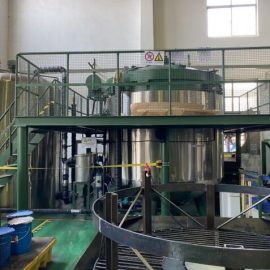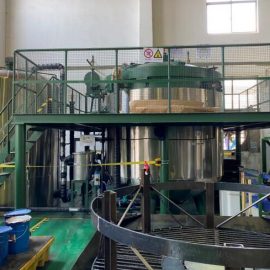QPQ Salt Bath Liquid Nitriding Process Characteristics And Application
1. QPQ salt bath liquid nitriding process:
“QPQ” is the abbreviation of “Quench-P0lish-Quench” in English. The original meaning is quenching, polishing and quenching. It is after the salt bath compound treatment, in order to reduce the surface roughness of the workpiece, the surface of the workpiece can be polished once, and then oxidized in the salt bath. This is required for precision parts and workpieces with high surface roughness. It is very necessary. It is called QPQ salt bath compound treatment technology in China. QPQ salt bath composite treatment technology can greatly improve the wear resistance and corrosion resistance of the metal surface, and the workpiece will hardly be deformed. It is a new metal surface strengthening modification technology. This technology realizes the composite of the nitriding process and the oxidation process; the composite of nitride and oxide; the composite of wear resistance and corrosion resistance; the composite of heat treatment technology and anti-corrosion technology.
The QPQ salt bath composite treatment technology was invented by a German company in the 1970s. After decades of continuous development and improvement, the application range is becoming wider and wider. Therefore, it is regarded as a huge progress in the field of metal surface strengthening technology abroad. It is called a new metallurgical method. At present, QPQ salt bath composite treatment technology has also been widely promoted and applied in China, especially in automobiles, motorcycles, shaft products, electronic parts, textile machinery, machine tools, electrical switches, and molds.

2. Technical features:
1. Good wear resistance
In the QPQ process, the metal material reacts with the salt bath liquid at a working temperature of 570±10℃ to form a high-quality dense compound layer on the metal surface. The compound is completely composed ofεiron nitride, which can effectively improve the hardness and compactness of the metal surface, so that the metal surface has good wear resistance. The surface hardness of the metal material after treatment mainly depends on the alloying elements in the steel. The higher the content of alloying elements, the higher the hardness of the infiltration layer. According to the hardness of the infiltration layer, the commonly used materials can be divided into the following categories:
(1) Carbon steel, low alloy steel
Representative steel grades: 20, 45, TiO, 20Cr, 40Cr, etc. Surface hardness of infiltration layer: 500—700HV
(2) Alloy steel
Representative steel grades: 3CrW8V, Crl2MoV, 38CrMoAl, 1Crl3-4Cr13, etc. Surface hardness of infiltration layer: 850—1000HV
(3) High-speed steel, austenitic stainless steel
Representative steel grade: quenched Wl8Cr4V, W6Mo5Cr4V2 and 1Crl8Ni9Ti isotonic layer surface hardness: 1000-1250HV
(4) Cast iron
Surface hardness of infiltration layer: >500HV
The following figure shows the sliding wear test data of a 40Cr material after different treatment methods. Based on the QPQ wear value of 0.22mg, the wear resistance of the QPQ process is 2.1 times that of hard chromium plating and 2.8 times that of ion nitriding. 23.7 times of induction hardening and 29.4 times of conventional hardening.
2. Good corrosion resistance
45# steel undergoes the QPQ salt bath compounding process, decorative chromium plating, hard chromium plating and ordinary blackening treatment, and the neutral salt spray test comparison with 1Cr18Ni9Ti stainless steel and 1Cr13 material. It can be seen that the corrosion resistance of 45# steel after QPQ treatment is 5 times that of 1Cr18Ni9Ti stainless steel, 70 times that of hard chromium plating, and 280 times that of ordinary blackening. After other materials are processed by QPQ process, the neutral salt spray test can reach 100-300 hours.
3. Good fatigue resistance
The metal surface treated by the QPQ salt bath compound process introduces and produces a high residual compressive stress, which results in a greatly improved fatigue strength of various types. Tests have shown that the fatigue strength can be increased by about 100%, and the point is slowed down. Surface defects such as corrosion and rust.
4. Minimal deformation
Due to the low process temperature of QPQ salt bath composite treatment technology, there will be no structural transformation below the phase transformation point of steel. Therefore, it is compatible with hardening processes such as quenching, high-frequency quenching, carburizing quenching and carbonitriding that generate huge structural stress. In comparison, the deformation of the workpiece after treatment is much smaller. At the same time, after nitriding at 570-580°C, the workpiece must be kept at 350-400°C for 15-20 minutes, which will greatly reduce the thermal stress generated when the workpiece is cooled. Therefore, the workpiece is almost not deformed after the QPQ salt bath compound process is processed. The smallest hardening technology can effectively solve the hardening deformation problems that are difficult to solve by conventional heat treatment methods.
5. Low carbon and environmental protection
The German Digaosha company that invented the process won the German Environmental Protection Award for this process. In China, the QPQ treatment process has been tested and identified by relevant environmental protection departments, and has been proved to be pollution-free, pollution-free, and heavy metal-free by users across the country. And to replace some heavy pollution processes such as electroplating.
6. It can replace multiple processes and reduce time cost
After the metal material is treated by the QPQ salt bath compound process, it can improve its hardness and wear resistance while also improving its corrosion resistance, so it can replace conventional quenching (ion nitriding, high-frequency quenching, etc.) one tempering and one firing Multiple processes such as black (chrome plating) greatly shorten the production cycle and reduce production costs. A large amount of production data shows that QPQ treatment can save 50% energy compared with carburizing and quenching, and save 30% cost compared with hard chromium plating, and it is cost-effective.
3. Application scope:
1. The most suitable material:
Various structural steels: passivated iron, Q235, 20, 20Cr, 20CrMnTi, 20CrNiMo, 35CrMo, 42CrMo, 45, 40Cr, 50CrV, 65Mn, 38CrMoAl.
Various tool steels: T7~T12, 5CrMnMo, 5CrNiMo, 3Cr2W8V, GCrI5, HI3 (0.35%C, 1.5% Mo, 5%Cr, 1%Si, 1%V), Cr12MoV, various high-speed steels .
Various stainless steels: 0Crl3 ~ 4Crl3, 201, 301, 304, 316, 1Cr18Ni9Ti, 0Crl8Nil2MoTi, 4Cr9Si2, 5Cr21Mn9Ni4N.
Various cast irons: gray iron, malleable cast iron, ductile cast iron, wear-resistant alloy cast iron.
Various iron-based powder metallurgy parts
2. Applied industries:
Automobiles, motorcycles, locomotives, internal combustion engines, textile machinery, construction machinery, light industrial machinery, pump and valve equipment, hydraulic machinery, printing and packaging machinery, chemical machinery, power tools, agricultural machinery, machine tools, tools and molds, etc., high and low voltage electrical switches The requirements on parts such as wear resistance, corrosion resistance, fatigue resistance and seizure resistance.
3. Typical application:
Engine valves, crankshafts, cylinder liners, gears, cams, bearings, spindles, sliders, steering arms, car wiper ball joint shafts, guide rails, hydraulic cylinders, universal joints, connecting pins, various molds, pistons, threaded screws, bolts Nuts, pump bodies, high-speed steel drills, barrels, various tools, flanges, key pins, gaskets, shells, etc.

Effect of QPQ Nitriding Process On Thickness of 42CrMo Piston Rod 40Cr Steel Quenching And Tempering Treatment Process Study on QPQ Nitriding Process of 42CrMo Piston Rod



Contact us
Your email address will not be published. Required fields are marked *